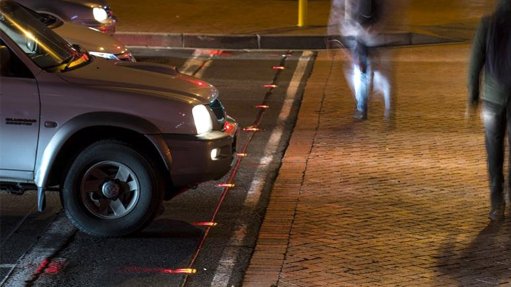
The in-road warning lights at a pedestrian crossing along Buitengracht street
The City of Cape Town’s Urban Mobility Directorate has reinstalled in-road warning lights at two pedestrian crossings along Buitengracht street in Cape Town.
These intersections form part of major pedestrian routes between the central business district (CBD) and Green Point, and are frequented by locals and tourists.
During the preparation for the 2010 FIFA World Cup, there was a need to provide pedestrians with a safe passage over Buitengracht street when walking between the CBD and the V&A Waterfront.
One of the safety features decided on at the time was to install in-road warning lights that operate in sync with red traffic signals, indicating to vehicular traffic to stop.
The in-road warning lights were installed to reduce the occurrence of drivers stopping beyond the stop line and within the pedestrian crossing, thereby forcing pedestrians to divert around the stopped vehicles – sometimes outside of the crossing itself.
“Reinstalling these lights forms part of our efforts to renew city infrastructure that has worked effectively in the past, and to incorporate innovative transport nudging techniques which is a popular way of encouraging better driver behaviour across major international cities worldwide,” says City of Cape Town Urban Mobility MMC Rob Quintas.
“The purpose of the red in-road warning lights is to create a visual barrier ahead of the pedestrian crossing line so that drivers get the message that stopping beyond the lights is not allowed.
“We intend to motivate to the Minister of Transport for the inclusion of these lights in the Southern African Development Community Road Traffic Signs Manual (SADC-RTSM) in the current financial year.
“The adoption of lane lights within the Road Traffic Signs Manual will allow us to implement this light system at other major intersections where this problem exists,” says Quintas.
The original installation was undertaken as a pilot project with the consent of the Minister of Transport, who is required to approve the testing of new road traffic signs and markings that are not provided for in the manual.
The SADC-RTSM is a standardised set of signs and markings to which countries within the SADC region subscribe. It is also enforced by law in South Africa.